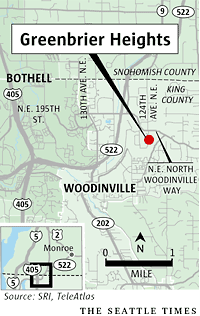Greenbrier Heights "model" community

In 2004, Marc and Amanda Lopez moved with their four children to a four-bedroom town house in Woodinville's Greenbrier Heights development. It was new, spacious, near other families and, best of all, affordable.
Two years later, the Lopezes have added another child to the family and count themselves lucky to have found a home in this unusual Puget Sound neighborhood.
The affordability, design and family-friendly atmosphere that Greenbrier Heights offers its residents won the neighborhood and the seven-member partnership that built it a commendation from Gov. Christine Gregoire last month. The governor's award honored the community, along with five others in the state, as a "model affordable livable community." That means similar neighborhoods throughout the state could be based on the success of Greenbrier Heights.
The neighborhood, located just north of downtown and close to public transit, is a mix of apartment buildings, rental town houses and traditional single-family, owner-occupied homes. Some homes, like the Lopezes', are rented at below-market rates for families and seniors. Some are sold through affordable-housing programs.
Green spaces and a community center draw families out for frequent neighborhood gatherings and provide a place for children to play with one another, Amanda Lopez said.
"We had a real diversity of needs here and I think it's being met," said Arthur Sullivan, program manager at A Regional Coalition for Housing (ARCH), one of the organizations that worked to see the project to completion. "The difference here is we didn't want it to become all low-income rental housing, which is what everyone thinks of when they think of East Coast-style project housing."
The community is a far cry from the housing projects typical of the East Coast, which many housing organizations such as ARCH try to avoid, Sullivan said. Problems such as crime, neglect and isolation from the surrounding community have plagued such neighborhoods, prompting cities such as Chicago, Boston and Cleveland to re-evaluate traditional housing projects.
Some cities with public-housing problems, Chicago most notably, have started to demolish projects and rebuild them as mixed-income neighborhoods like Greenbrier Heights.
The Woodinville neighborhood also stands out because of the collaboration that brought it about in the first place. The city of Woodinville, King County and ARCH teamed up with CamWest Development, DASH (Downtown Action to Save Housing, a nonprofit Eastside advocacy group), Shelter Resources and the National Development Council to piece together the funding that made Greenbrier Heights possible.
Sullivan said the development meets the needs of families living at many different income levels.
"Mixing the rental and ownership in one site is definitely a little bit different," he said. "Communities seem to feel a lot better when they have lots of needs met instead of just slamming it with one kind of housing."
Some of the neighborhood's single-family homes built for affordable sales have deeds that provide they can be sold only to other qualified low- and middle-income families. "But the homes with no restrictions are reselling at the same appreciation rates as homes in other Woodinville communities," he said.
Amanda Lopez said families of all income levels have been getting along well in the two years her family has called Greenbrier Heights home.
"Everyone is very friendly, and we have friends that are in all the houses and apartments," she said. "We all get together for neighborhood barbecues, things like that. It's great."
Nathan Hurst: 206-464-2112
